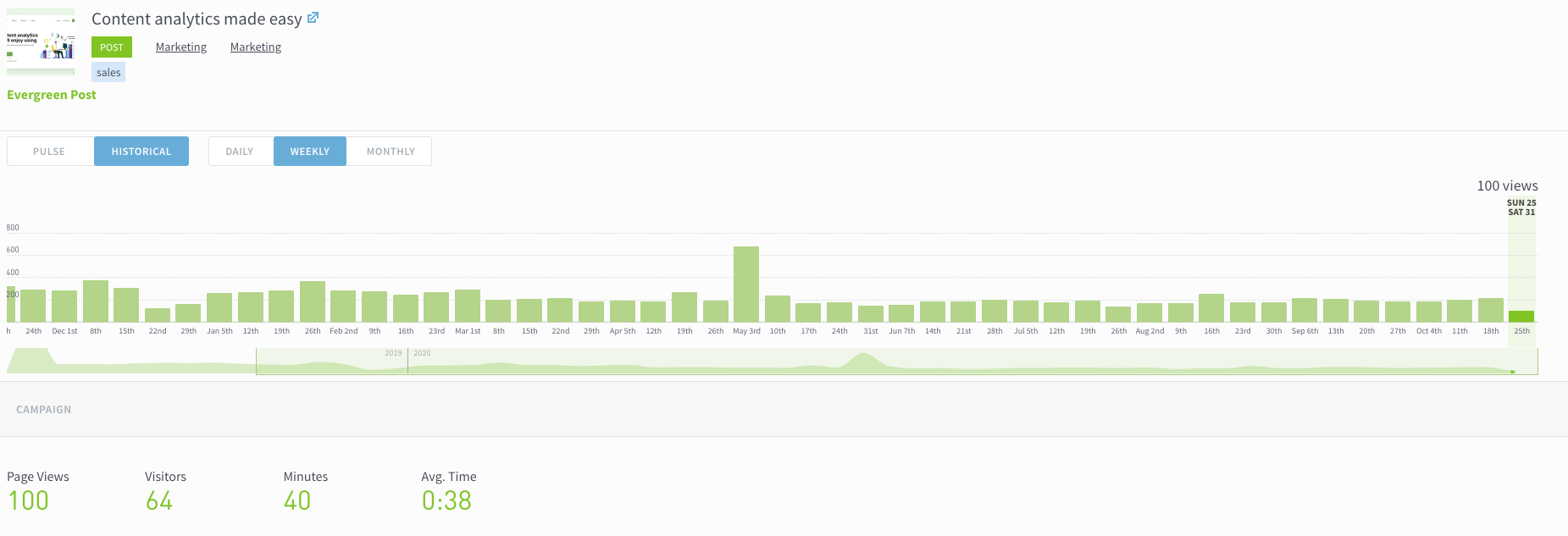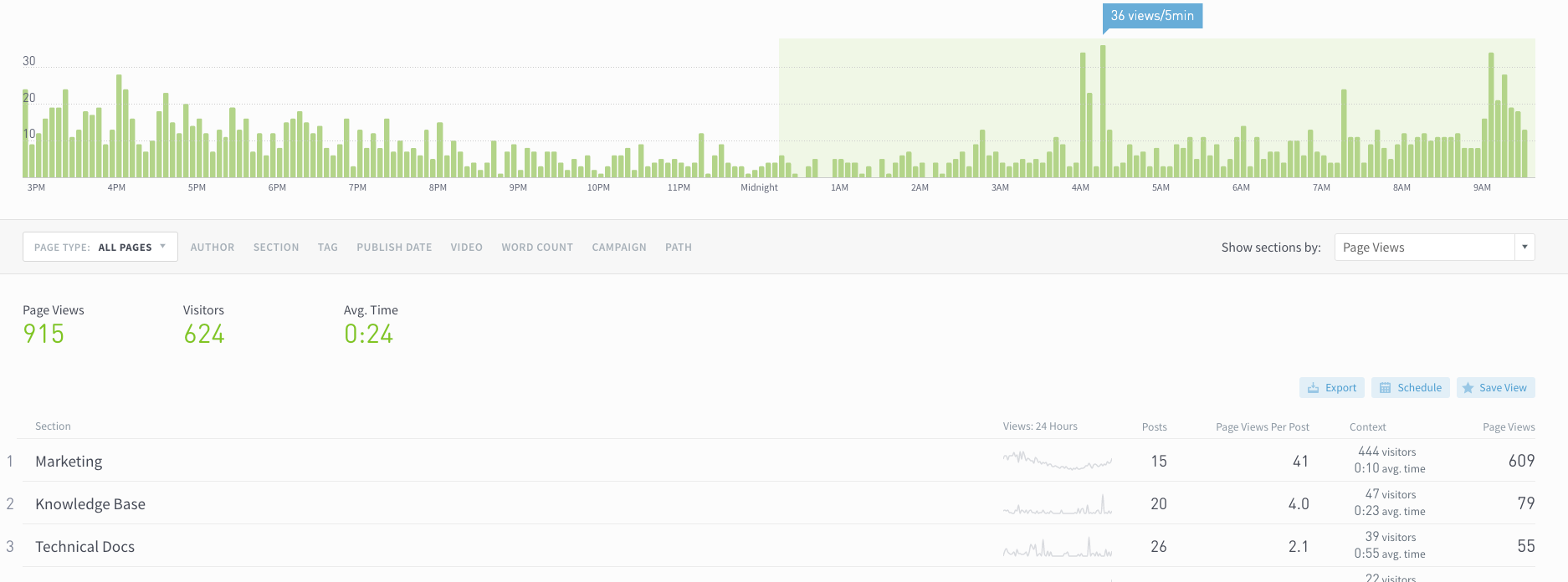7 KPIs That Measure The Impact of Your Content Marketing

Content marketing is subjective—it’s ruled by opinions and moved by personal preferences. But when you use objective data and work towards Key Performance Indicators (KPIs), you can identify which content is benefiting your organization and which isn’t.
Choosing the right KPIs helps you see where your marketing efforts are working and where you need improvement. To get the most out of your data, tie KPIs specifically to your content marketing goals throughout all stages of the marketing funnel.
Let’s look at seven metrics to track your progress toward three common content marketing goals.

Content marketing KPIs for boosting brand awareness
Building brand awareness targets new prospective customers and helps audiences recognize and relate to your business. Here are three KPIs to track and tools to understand how your content is contributing to that exposure:
1. Website traffic
A website visit is often the first touchpoint of a prospective customer’s journey through your marketing funnel. As a KPI, website traffic—the number and percentage of pageviews or visitors to your website—helps identify which channels, by source, foster the most awareness and ultimately bring the highest ROI.
Whether you’re focused on targeting new customers or encouraging repeat visits, you can segment your website traffic further into new, unique, or returning visitors to get a sense of how you’re tracking. To do this, you need an analytics platform that readily displays this data.
How to track it: Website traffic sources can be found under the Acquisition tab in Google Analytics in the Source/Medium report. It breaks down traffic based on the source channel. Examples: Google/organic, email/Mailchimp, and CPC/Google.
Parse.ly, however, offers a more user-friendly solution. All you need to do is click the “Referrers” tab in the dashboard, with all organic traffic sources in one place. To track paid acquisition, simply click the “Campaigns” tab. Parse.ly also allows you to drill down by referrer category or groups of campaigns.

2. Social visibility
Social visibility is important for brands because it makes the value you bring to customers easily accessible and recognizable. Social media is a competitive space, however, with 94% of marketers using social media for content distribution. Knowing which social media channels your target audience prefers will help you maximize your content marketing efforts.
How to track it: Parse.ly shows you how each piece of your content is performing across social media platforms, and which channels are driving traffic back to your site. See all the sources of traffic coming from Facebook, Twitter, LinkedIn, Instagram, and more through Parse.ly’s social referrals metric in the dashboard. You can also see how many likes and comments your content is getting with the social interactions metric.

3. Backlinks
Backlinks, or inbound links, are links from an external website to a page on another website. Consider them as upvotes on your content from other websites.
More backlinks to your content translate into better overall visibility to users, because Google rewards sites that have a higher concentration of backlinks with better SEO. However, 66.31% of pages don’t have a backlink and are missing out on this opportunity to get organic traffic.
How to track it: The easiest way to measure your backlink traffic is by using a tool like Alexa’s Competitive Backlink Checker. It shows you the percentage of backlinks your site is receiving amongst up to nine competitors.
Content marketing KPIs for increasing engagement
Once you get readers to come to your site, you want to keep them there. That means engaging your target audience with valuable content that builds trust beyond their initial interest. Use the following KPIs to measure how well you content is creating this engagement:
4. Engaged-time
Parse.ly’s engaged-time metric shows you how much time users spend actively engaged with your content. It’s a realistic gauge of how well your content marketing strategy is resonating with your audience.
Engaged-time can also show where adjustments can be made. For example, if readers are spending less time on your longer content, you might want to focus on creating more shorter-form pieces.
How to track it: Parse.ly’s “heartbeat” pixel tracks when readers are actively engaged with a piece of content and rolls that up into our engaged-time metric. In the Parse.ly dashboard, you can see the total engaged minutes and average engaged minutes that audiences spend with any piece of your content.

5. Top sections
Looking at your top performing sections reveals which topics are most engaging for your audience, providing inspiration for creating similar valuable content. For example, if the “tutorials” section of your blog is thriving in terms of engagement, creating more tutorial content will continue to amplify that engagement.
How to track it: Use Parse.ly to track the top-performing sections of your website in terms of pageviews and engaged-time. You can also use Parse.ly to quickly and easily generate a Top Listings Report that gives you recurring insight into the most popular sections, tags, authors, and pieces of content on your site.

6. Evergreen content
The typical online article has a lifespan of about three days, whereas evergreen content continues to garner attention and engagement far beyond that. Creating evergreen content ensures that you’re bringing a continuous stream of traffic and engagement.
Evergreen content is a gift that keeps on giving. So make sure you’re repromoting it to your audience regularly to maximize its impact.
How to track it: Parse.ly’s Evergreen Report shows an overview of your evergreen content performance, compares it to site-wide performance, and lists the top new and existing evergreen posts. You can also filter the Top Listings Report to show posts that are evergreen or candidates for becoming evergreen.
Content marketing KPIs for conversion
Once you’re able to successfully draw awareness to your brand and build engagement with your target audience, you can start to track how well your content is influencing prospective customers to take valuable, bottom-of-funnel actions.
7. Conversions
To understand the bottom-of-funnel impact of your content, you need visibility into how it influences calls to action (CTAs), like booking a demo, filling out contact forms, or downloading a piece of content. Tracking these conversions is a key component of calculating your content marketing ROI.
How to track it: Parse.ly Content Conversions is the most effective and easiest way to track how well your content drives those key bottom-of-funnel actions from your audience. Find detailed conversion information like which content converts the largest number of leads, which content contributes to the most conversions, and which types of conversions are the best for your content.

Track your KPIs with Parse.ly
To make your marketing campaigns pay off, you need to constantly track key content marketing KPIs then refine your strategy to improve your future efforts.
To get consistent visibility into the impact of your content marketing without having to spend hours sifting through data every day, consider a content analytics solution like Parse.ly. Book a demo to learn more.